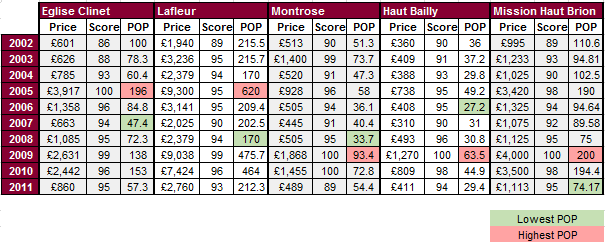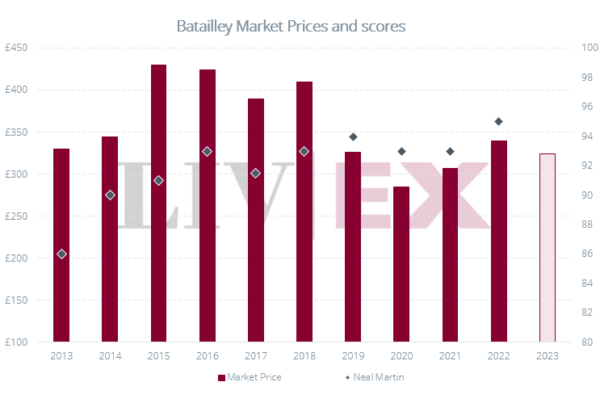Yesterday, we looked at the Bordeaux Chateaux with the smallest and largest price differences between their cheapest and most expensive vintages. A number of Chateaux were found to have a significant gap between these extremes, with the highest prices pushed up by buyers searching for top scoring wines. But, where does the value lie?
To understand this, we have taken the five Chateaux with the greatest difference between high and low prices, shown in the table below. Using POP* analysis – our loose measure of value – we have identified the best and worst value vintages for each estate.
The table uses Liv-ex Mid-Prices, calculated using merchant bid, offer and transaction prices.
In each case, the vintage offering the poorest POP value was also the Chateau’s most expensive. These are highlighted in red, and come exclusively from the acclaimed 2005 and 2009 vintages. All have been awarded a perfect 100 points from Robert Parker, with the exception of Lafleur 2005 which received 95+ from Parker – but 100 from James Suckling.
Conversely, the cheapest vintage is not the best value vintage for any of the above. Rather, it is the third or fourth least expensive which offer most value. These all have scores of 94 or 95 – close to the Chateaux’ average scores – and come from vintages which are neither considered outstanding nor poor. Have they been overlooked?
Possibly by buyers – but not by Parker. Eglise Clinet 2007, Haut Bailly 2006 and Mission Haut Brion 2011 are all amongst the highest scoring wines of their vintages, while Montrose and Lafleur 2008 still receive relatively high scores.
Even more telling are Parker’s notes. Montrose 2008 is described as “one of the superstars of the vintage” while he names Lafleur 2008 as “a wine to buy from this very under-rated vintage”. Eglise Clinet 2007 is “unquestionably the Pomerol of the vintage” – according to Parker – and he considers Haut Bailly 2006 to be “haute couture in a glass”.
Could the middle ground be the place to find value?
*A wine’s POP score is its price-over-points ratio, our loose measure of value. It is calculated by dividing the price of a nine-litre case of wine by a shortened 20-point score. We have calculated this 20-point score by simply subtracting 80 from the official rating from The Wine Advocate (for barrel-score spreads we use the mid-point of the score), on the basis that any wine under 80 points is unlikely to attract a secondary market. In theory, the lower the POP score the better value a wine is. All scores from erobertparker.com.






